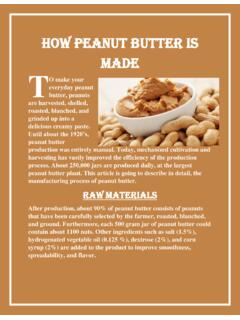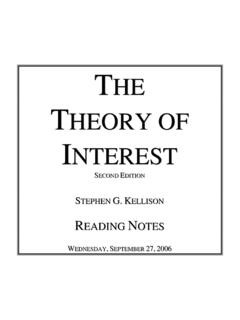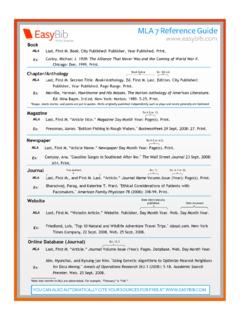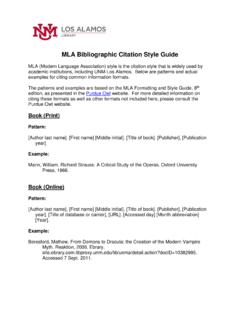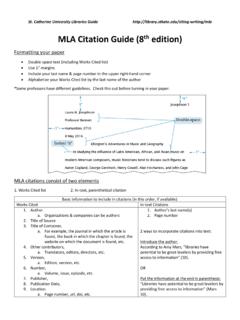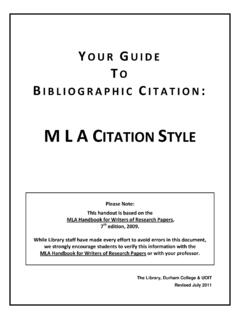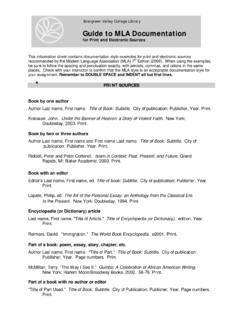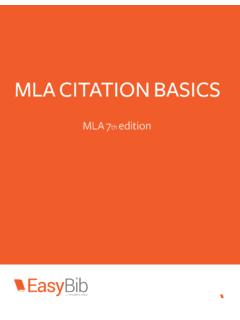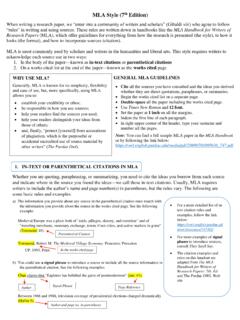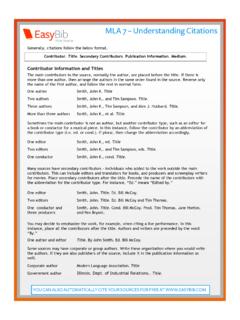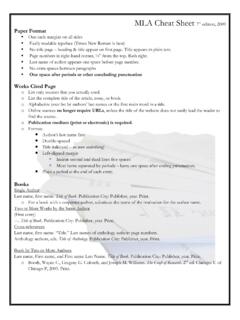Transcription of MLA 7th Edition Quick Reference - sites.psu.edu
1 MLA 7th Edition Quick Reference April 2010 Please refer to the following information and examples for formatting a paper and using sources in the Modern Language Association of America (MLA) style, widely used in humanities disciplines. Consult the 7th Edition of the MLA Handbook for Writers of Research Papers for additional information. Copies are available in the Nittany Success Center and in the library. An online MLA Quick Citation guide is also available from the Citation Styles link on the Penn State University Libraries home page.
2 Basic Information MLA Handbook, pages 116-20 1. Margins are to be one inch (1 ) from the top, bottom, and sides. 2. Double space everything, including block quotes and citations. 3. Use 12-point Times New Roman font. Note: This is not the default in Microsoft Word 2007, so make sure to change the font and size. Do not use different fonts for titles or other special effects. 4. Justify only on the left side of the paper. 5. Include a header with your last name and page number in the upper right-hand corner.
3 Check with your instructors to find out their preference for numbering the first page of your paper. 6. Indent the beginning of each paragraph using one tab space. Do not leave extra space between paragraphs. 7. Center the title and capitalize all the main words. 8. The Works Cited page follows the text of the paper, beginning on a new page and continuing the page numbering of your paper. 9. Each Appendix should be on a separate page. 10. Check the MLA Handbook for setting up charts, tables, and graphs.
4 For most purposes, these should be integrated into the body of the paper. Your name Professor s name Class Day Month Year Title of Your Paper The first paragraph of your paper begins right under the title. Do not leave any extra space between the heading, the title of the paper, and the first paragraph. Do not put any extra space between the paragraphs. Heading Header Last Name 1 1 1 1 2 General Guidelines for Authors and Titles MLA Handbook, pages 79-92 1. Refer to the author by his or her full name the first time it is mentioned in the text, but by last name only thereafter, unless you have two authors with the same last name.
5 In that case, use both the first and last names consistently. 2. Titles of books, plays, magazines, journals, newspapers, movies, television shows, compact discs, and Web sites are to be italicized. 3. Titles of articles, short stories, essays, poems, and songs are in quotation marks. 4. Capitalize the first and last words and all main words. Examples: Eight Days a Week, Great Expectations, Wall Street Journal, The Simpsons, The Raven Plagiarism MLA Handbook, pages 51-61 Plagiarism is using someone else s work and submitting it as your own, failing to give appropriate acknowledgement when directly quoting or paraphrasing another, or presenting another s line of thinking without giving credit.
6 Do not repeat the author s key words or sentence structure when paraphrasing. Commonly-known or understood material such as the biography of an author, a scientific truth, or historical dates do not have to be documented, nor do proverbs, sayings, and clich s. When writing, keep the following in mind: 1. Differentiate between paraphrase or summary and directly-quoted material. 2. Do not copy and paste material directly from a source without citing it. 3. Memorable or key phrases must be reworded unless directly quoted.
7 4. Document or cite all lines of argument or reasoning. Use of Numbers MLA Handbook, pages 81-85 1. Spell out numbers that can be written in one or two words (four, thirty-five); use numerals to represent longer numbers (110, 5 ). 2. If the paper calls for a series of numbers or frequent use of numbers, such as statistical findings, use numerals. Also, use numerals for numbers preceding units of measurement (17 amperes). 3. Do not begin a sentence with a numeral spell it out. 4. Express related numbers in the same format (5 out of 50 states).
8 5. Following are examples of the format for inclusive numbers for page numbers in your Works Cited list. The second number is given in full through ninety-nine and when necessary for clarity. 13-35 83-110 101-07 191-217 1954-59 55-99 625-884 125-52 923-1003 1608-774 3 Internal Documentation (In-text citations, parenthetical references) MLA Handbook, pages 213-32 Every time you paraphrase or directly quote a source, you must give the reader the author s last name and the page number of the source, either in the tag (introductory) line or in parentheses.
9 Do not use a comma between the author s name and the page number. Paraphrase wherever possible. Section in the MLA Handbook is worth reading as it contains helpful guidelines for incorporating borrowed information into your text and for using parenthetical references. Keep in mind, When a source has no page numbers or any other kind of Reference numbers, no number can be given in the parenthetical Reference (MLA 221). Author s name in tag line He was obeyed, writes Joseph Conrad of the manager in Heart of Darkness, yet he inspired neither love nor fear, nor even respect (87).
10 Author s name in parentheses The author, speaking of the manager in Heart of Darkness, says that He was obeyed, yet he inspired neither love nor fear, nor even respect (Conrad 87). More than three authors If a work has more than three authors, you may either give all the last names followed by the page number, or use et al. followed by the page number. Notice that et al., which means and others, ends with a period. Example: (Bell, Peters, Monsour, and Pope 19) or (Bell et al. 19). Use the same format for the names in your list of works cited.


